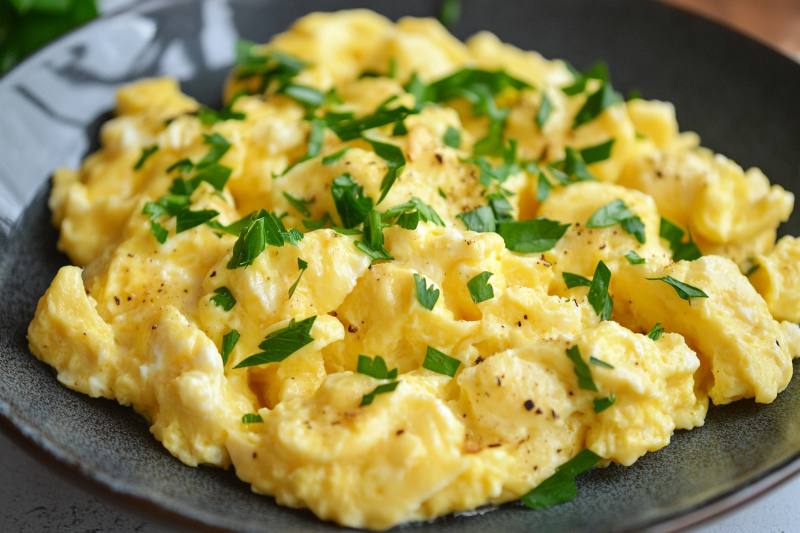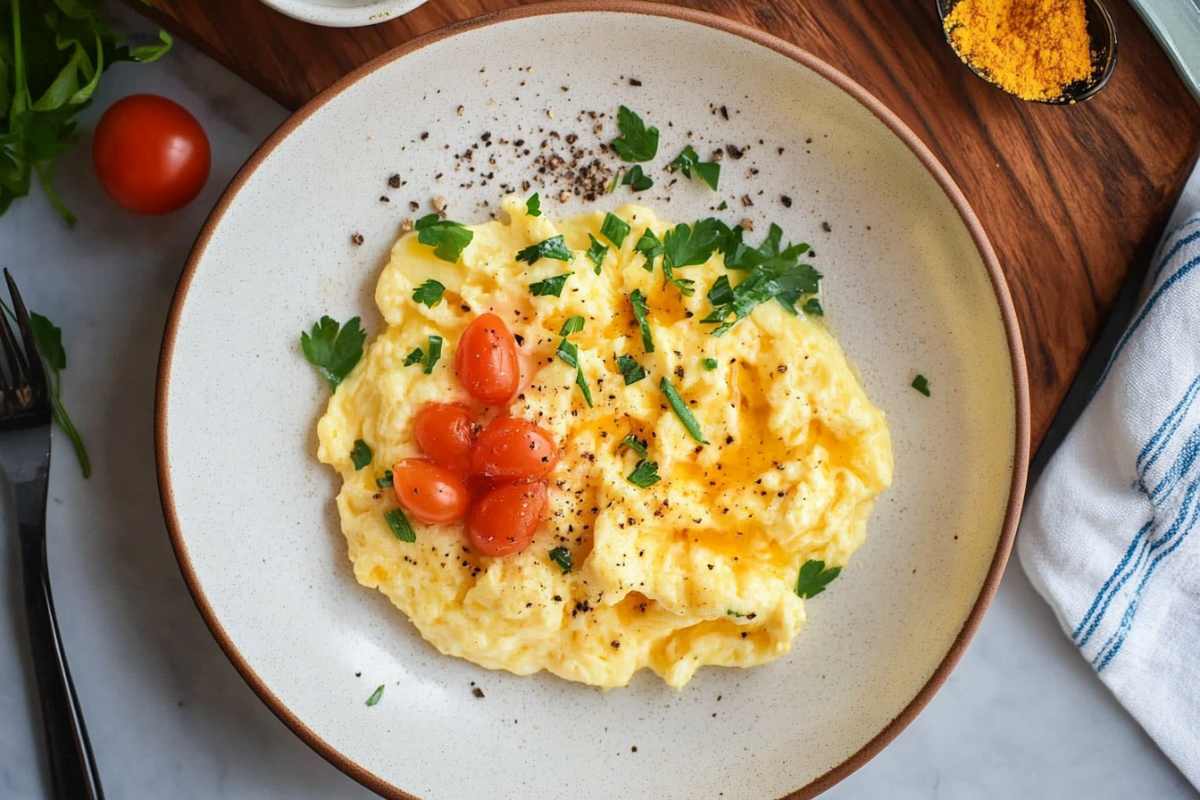Scrambled eggs are among the most beloved breakfast dishes around the world. Their versatility and simplicity make them a popular choice for all types of meals, from quick breakfasts to more elaborate brunch spreads. Whether you like them fluffy, soft, or loaded with extras, this guide covers everything you need to know to make perfect scrambled eggs every time.
Ingredients for Scrambled Eggs
The ingredients you choose can have a significant impact on the flavor and texture of your scrambled eggs. While the basics are simple, there are various combinations and additions that can enhance the dish significantly.

Basic Ingredients in Detail
Eggs: The Core Ingredient
- Freshness Matters: Fresher eggs yield a better flavor and texture, making them richer and more vibrant. For the best results, crack the eggs just before cooking.
- Egg Size: Large eggs are standard for most recipes, but you can adjust the number depending on the size of the eggs.
- Organic Eggs: While we avoid nutritional discussions, organic eggs are often preferred for their taste and quality.
Milk or Water: Enhancing the Texture
- Milk: Adding milk (whole, skim, or plant-based) creates a creamy texture. Use approximately 1 tablespoon per egg for optimal results.
- Water: Water helps achieve fluffy scrambled eggs, as it steams the eggs while they cook.
- Heavy Cream: For an extra indulgent texture, use heavy cream. It makes the eggs incredibly rich and luxurious.
For another classic breakfast addition, check out Perfecting Apple Pancakes to complete your morning feast.
Butter or Olive Oil: Adding Richness
- Butter: Butter adds a rich flavor to the eggs and is the most popular fat used for cooking scrambled eggs. Melt the butter over medium-low heat before adding the eggs.
- Olive Oil: While olive oil gives a lighter taste, it is ideal for those who want a more savory flavor without the richness of butter.
- Combination of Fats: Some cooks combine butter and oil to balance flavor and prevent burning.
Salt & Pepper: Simple Seasonings
- Salt: It’s best to add salt just before or during cooking to enhance the natural flavors of the eggs.
- Pepper: Freshly ground black pepper gives a nice kick to the eggs. White pepper can be used for a milder, less spicy flavor.
For tips on achieving the right balance of spices in your dishes, read Chicken Caesar Wraps Recipe.
Step-by-Step Guide to Making Scrambled Eggs
Achieving perfect scrambled eggs requires careful attention to each step of the process. Let’s break it down into a detailed guide:
Step 1: Whisking the Eggs to Perfection
- Use a Fork or Whisk: Beat the eggs thoroughly to break up the yolks and whites, creating a uniform mixture. Use a fork or whisk for best results.
- Add Liquid: Add milk, water, or heavy cream to the beaten eggs. The amount depends on your preference: milk or cream for a creamier texture, water for fluffiness.
- Seasoning During Whisking: While some chefs prefer to season at the end, adding a pinch of salt to the eggs before cooking helps enhance the flavor during the whisking process.
Step 2: Preheating the Pan for Optimal Cooking
- Choose the Right Pan: Use a non-stick skillet or a well-seasoned cast iron pan to prevent the eggs from sticking. The pan size should match the number of eggs you are cooking.
- Heat the Pan Gradually: Preheat the pan over medium-low heat. Adding the eggs to a cold or overly hot pan can ruin the texture.
- Add Butter or Oil: Melt butter or add olive oil before pouring in the eggs. Ensure the fat is evenly spread across the pan to prevent sticking.
Explore more techniques for cooking breakfast dishes in Fluffy Cinnamon Rolls from Scratch, which also involves careful temperature control.
Step 3: Cooking the Eggs Slowly and Gently
- Pour the Eggs: Pour the beaten eggs into the warm skillet and allow them to sit undisturbed for a few seconds.
- Begin Stirring: Use a rubber spatula to gently stir the eggs. Push the eggs from the edges toward the center, allowing curds to form.
- Adjust the Heat: If the eggs start cooking too quickly, reduce the heat to maintain a gentle cooking pace.
- Don’t Overstir: Stirring too much can create smaller curds, while less stirring creates larger, creamier curds.
If you enjoy Mexican-inspired breakfast options, consider trying Pico de Gallo alongside scrambled eggs for a fresh kick.
Step 4: Final Touches and Serving
- Remove Eggs Early: For soft scrambled eggs, remove the pan from heat when the eggs are still slightly runny. The residual heat will finish cooking them.
- Season Again: Add a final touch of salt and pepper to taste before serving.
- Garnish: Top with chopped herbs like chives or parsley for added flavor and color.
Pair your scrambled eggs with Classic French Croissant Recipe for a truly decadent breakfast.
Tips for Perfect Scrambled Eggs
Here are some detailed tips to improve your scrambled egg technique:
Achieving Fluffy Scrambled Eggs
- Room-Temperature Eggs: Allow the eggs to come to room temperature before cooking. Cold eggs can lead to uneven cooking.
- Add Air by Whisking: Whisk the eggs vigorously to incorporate air, which helps achieve fluffiness.
- Use a Seltzer Water Trick: Add 1 tablespoon of seltzer water per egg while whisking. This technique creates light, airy eggs.
Achieving Creamy Scrambled Eggs
- Add Butter Gradually: For extra creaminess, add small cubes of butter during cooking. This creates layers of richness.
- Stir Slowly: Stirring gently and slowly helps the eggs retain their creamy texture.
- Use Heavy Cream: Swap milk for heavy cream to make the scrambled eggs richer and creamier.
For other rich and comforting recipes, try making Creamy Cauliflower Soup as a side dish.
Avoiding Common Mistakes
- Don’t Overcook: Always remove the pan from heat when the eggs are still slightly runny.
- Avoid High Heat: High heat can make the eggs tough and rubbery, so maintain medium-low heat throughout cooking.
- Stir Consistently: Consistent stirring ensures even cooking and prevents any part of the eggs from overcooking.
If you are interested in perfecting more breakfast classics, read Waffles: The Ultimate Guide to Perfection to expand your morning repertoire.
Variations in Scrambled Eggs Recipes
There are countless ways to customize scrambled eggs, and here we explore some of the most popular and creative variations.
1. Creamy Scrambled Eggs
- Use More Butter: Add an extra tablespoon of butter to make the eggs creamier.
- Heavy Cream Addition: Replace milk with heavy cream for a luxurious texture. Stir slowly to maintain a creamy consistency.
2. Cheesy Scrambled Eggs
- Cheddar Cheese: Add grated cheddar cheese just before the eggs are fully set. Stir gently to melt the cheese into the eggs.
- Feta or Goat Cheese: For a tangy flavor, crumble feta or goat cheese into the eggs as they cook. This creates a rich, cheesy bite.
Try pairing these cheesy scrambled eggs with Fish Tacos Made Easy for a unique brunch combination.
3. Veggie-Packed Scrambled Eggs
- Spinach and Mushrooms: Sauté chopped spinach and sliced mushrooms before adding the eggs. This adds a hearty flavor to the dish.
- Bell Peppers and Onions: Sauté diced bell peppers and onions, then mix them into the scrambled eggs. This variation adds sweetness and a bit of crunch.
For more vegetable-based inspirations, consider making Orzo Vegetable Soup as a side dish.
4. Herb-Infused Scrambled Eggs
- Fresh Herbs: Mix in herbs like chives, dill, or parsley for a burst of fresh flavor. Add them during the final stages of cooking to maintain their color.
- Spice It Up: Add a dash of paprika, chili flakes, or cayenne pepper to spice up the scrambled eggs.
For an herb-infused recipe idea, check out Tomato and Basil Soup.
5. Vegan Scrambled Eggs
- Tofu Scramble: Crumble firm tofu and sauté with turmeric, black salt, and nutritional yeast to mimic scrambled eggs’ flavor and texture.
- Chickpea Flour Scramble: Mix chickpea flour with water and spices, then cook like regular scrambled eggs. This creates a similar texture and appearance to traditional eggs.
Explore more vegan meal options in Zucchini Bread: Classic, Vegan, and Creative Variations.
Advanced Techniques for Making Scrambled Eggs
Master more refined techniques to elevate your scrambled eggs:
Slow-Cooked Scrambled Eggs
- Low and Slow: Cook the eggs over very low heat, stirring gently throughout the process. This technique creates a silky, custard-like texture.
- Gradual Butter Addition: Add butter in small amounts during cooking to enhance the creaminess.
Bain-Marie (Water Bath) Scrambled Eggs
- Set Up: Place a bowl over a pot of simmering water and whisk the eggs continuously until they thicken.
- Final Stir: Add small amounts of butter toward the end for a soft and smooth texture.
Explore more refined techniques in Classic Tiramisu Recipe: Step-by-Step Guide, which also requires careful temperature control.
Fluffier Scrambled Eggs with Seltzer Water
- Whisking with Seltzer: Add a splash of seltzer to the beaten eggs and whisk thoroughly. The carbonation creates a lighter and airier result.
- Cooking Method: Use medium-low heat and gentle stirring to maintain the fluffy texture.
For more fluffy recipe inspirations, check out Easy Homemade Cinnamon Granola Recipe, which pairs well with scrambled eggs for breakfast.
Storing and Reheating Scrambled Eggs
Best Practices for Storing Scrambled Eggs
- Airtight Container: Place leftover scrambled eggs in an airtight container to maintain freshness.
- Refrigeration: Store the eggs in the fridge for up to 2 days.
Reheating Tips for Scrambled Eggs
- Microwave: Heat in 15-second intervals, stirring in between to prevent overcooking.
- Stovetop: Reheat in a non-stick skillet with a small amount of butter or milk to restore creaminess.
Alternative Breakfast Recipe: If you’re looking to expand your breakfast repertoire, try making Egg Muffins. These portable, protein-packed bites offer a flavorful and convenient alternative to traditional scrambled eggs, perfect for busy mornings or meal prepping.
Frequently Asked Questions (FAQs)
What Pan is Best for Scrambled Eggs?
- Non-Stick Skillet: A non-stick skillet is ideal as it prevents sticking and allows for easy stirring.
- Cast Iron Pan: A well-seasoned cast iron pan can also work well for making scrambled eggs, adding a slight richness to the flavor.
How Do You Make Scrambled Eggs Fluffier?
- Use Water or Seltzer: Adding water or seltzer helps create steam while cooking, making the eggs fluffier.
- Vigorous Whisking: Whisking the eggs thoroughly before cooking incorporates air, adding lightness.
Can You Make Scrambled Eggs in the Microwave?
- Yes, but use a microwave-safe bowl and cook in 15-second intervals to avoid overcooking. Stir often.
How Do You Prevent Runny Scrambled Eggs?
- Proper Cooking Temperature: Cook on medium-low heat and stir constantly to prevent runny eggs.
- Add Dairy Gradually: If using milk or cream, add it gradually to maintain the right texture.
Conclusion
Scrambled eggs are not just a breakfast staple; they’re a versatile dish that can be adapted to suit various tastes and cooking styles. Whether you prefer them fluffy, creamy, or packed with herbs and vegetables, mastering the art of making scrambled eggs is all about understanding the techniques and ingredients that work best for your desired texture and flavor. By experimenting with different variations—such as cheesy, veggie-packed, or even vegan options—you can enjoy scrambled eggs in a new way every time.
With the step-by-step guide, advanced techniques, and useful tips covered in this article, you’re equipped to make scrambled eggs that are consistently delicious. Remember, the key to perfection lies in low heat, gentle stirring, and removing the eggs from heat at the right moment. So, gather your ingredients, heat up the skillet, and enjoy one of the simplest yet most satisfying dishes you can create at home.

